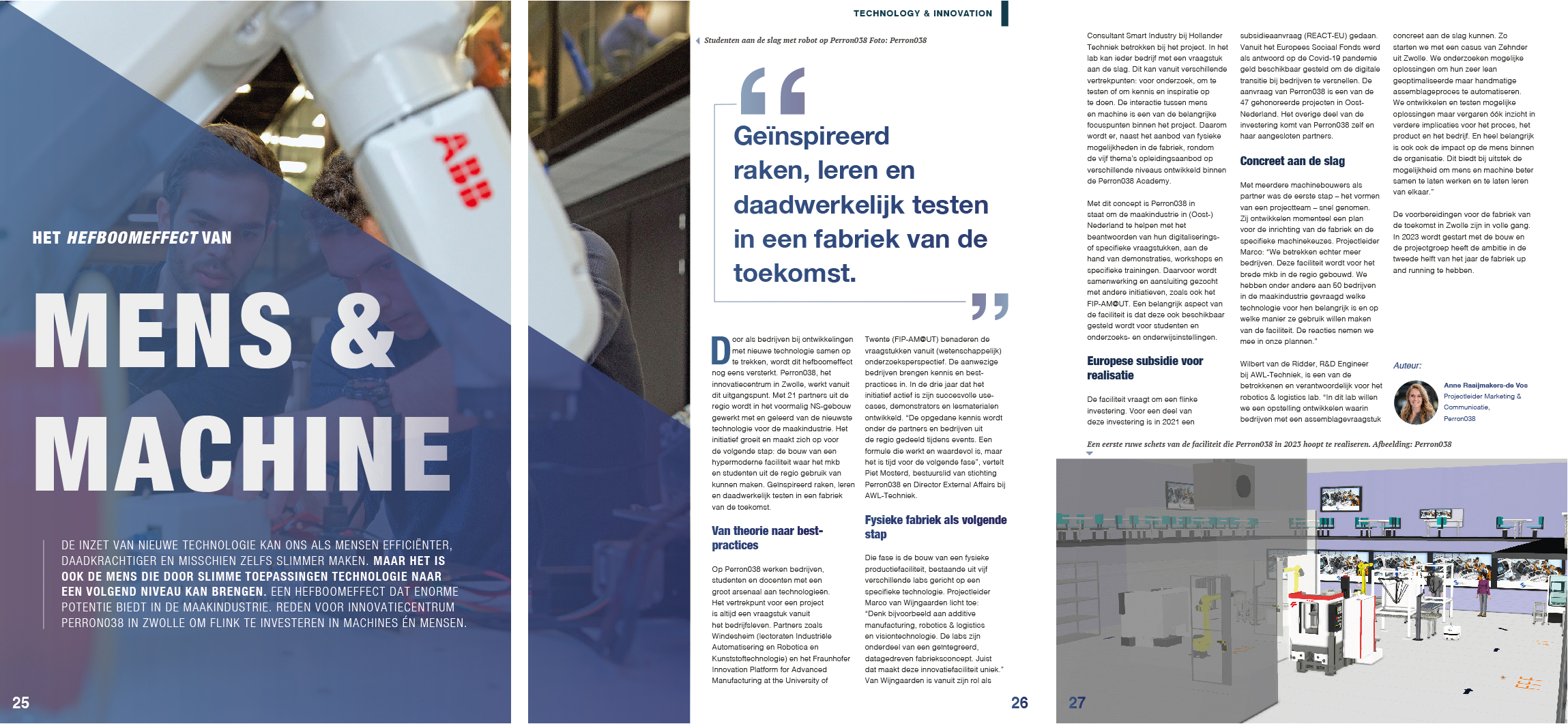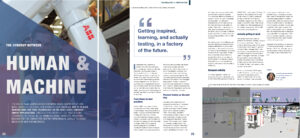This article was published in the Fraunhofer Innovation Platform magazine.
The use of new technology can make us as humans more efficient, more decisive and perhaps even smarter. But it is also humans who can take technology to the next level through smart applications. A leverage point that offers enormous potential in the manufacturing industry. Reason for innovation centre perron038 in Zwolle to invest heavily in machines as well as people.
Getting inspired, learning and actually testing in a factory of the future.
If companies work together on developments with new technology, this leveraging effect is even stronger. Perron038, the innovation centre in Zwolle, works from this starting point. With 21 partners from the region, in the former NS building they work with and learn from the latest technology for the manufacturing industry. This initiative is growing and is preparing for the next step: the construction of a state-of-the-art facility that SMEs and students from the region can make use of. Getting inspired, learning, and actually testing, in a factory of the future.
From theory to best practices
At Perron038, companies, students, and teachers work with a large range of technologies. The starting point for a project is always a problem statement coming from a business. Partners such as Windesheim (research groups Industrial Automation and Robotics and Plastics Technology) and the Fraunhofer Innovation Platform for Advanced Manufacturing at the University of Twente (FIP-AM@UT) approach issues from a (scientific) research perspective. The Perron038 associated companies contribute knowledge and best practices. In the three years since the start of the initiative, successful use cases, demonstrators, and teaching materials have been developed. “The knowledge gained is shared among the partners and companies from the region during events. A formula that works and is valuable, but it’s time for the next step,” says Piet Mosterd, board member of the Perron038 Foundation and Director External Affairs at AWL-Techniek.
Physical factory as the next step
That step is the construction of a physical production facility, consisting of five different labs focusing on a specific technology. Project manager Marco van Wijngaarden explains: “Think, for example, of additive manufacturing, robotics & logistics, and vision technology. The labs are part of an integrated, data-driven factory concept. That is exactly what makes this innovation facility unique.” Van Wijngaarden is involved in the project through his role as Consultant Smart Industry at Hollander Techniek. In the
lab, every company can work on their own problem or research question. This can be for different objectives: for research, to test, or to gain knowledge and inspiration. The interaction between man and machine is one of the important focus points within the project. That is why, in addition to the wide range of physical possibilities in the factory, training courses at different levels around the five focal themes are being developed within the Perron038 Academy.
With this concept, Perron038 is able to help the manufacturing industry in the (Eastern) Netherlands to answer their digitisation or other specific questions, by means of demonstrations, workshops, and specific training courses. To this end, cooperation and connection is sought with other initiatives, such as the FIP-AM@UT. An important aspect is that the facility is also available to students, and research and educational institutions.
European subsidy
This facility requires a substantial investment. For part of this investment, in 2021 Perron038 applied for a subsidy (REACT-EU). In response to the Covid-19 pandemic, the European Social Fund made money available to accelerate the digital transition at companies. Perron038’s application is one of the 47 projects awarded funding in the east of the Netherlands. The remaining part of the investment comes from Perron038 itself and its affiliated partners.
Actually getting to work
With several machine builders as partners, the first step – forming a project team – was quickly taken. They are currently developing a plan for the layout of the factory and the specific machine choices. Project manager Marco: “We are, however, involving more companies. This facility is built for a broad range of SMEs in the region. Therefore, we asked 50 companies in the manufacturing industry which technology is important to them and how they would like to use the facility. We take their responses into account for our plans.”
Wilbert van de Ridder, R&D Engineer at AWL-Techniek, is one of the people involved and responsible for the robotics & logistics lab. “In this lab, we want to develop a set-up in which companies can actually work on an assembly issue. For example, we start with a case of Zehnder from Zwolle. We are investigating possible solutions to automate their highly lean optimised, but manual assembly process. We develop and test possible solutions, but also gain insight into further implications for the process, the product, and the company. And, very important is also the impact on the people within the organisation. This offers an excellent opportunity to make man and machine work better together and learn from each other.”
Preparations for the factory of the future in Zwolle are in full swing. Construction will start in 2023 and the project group has the ambition to have the factory up and running in the second half of the year.
Click on the image above to download the article



